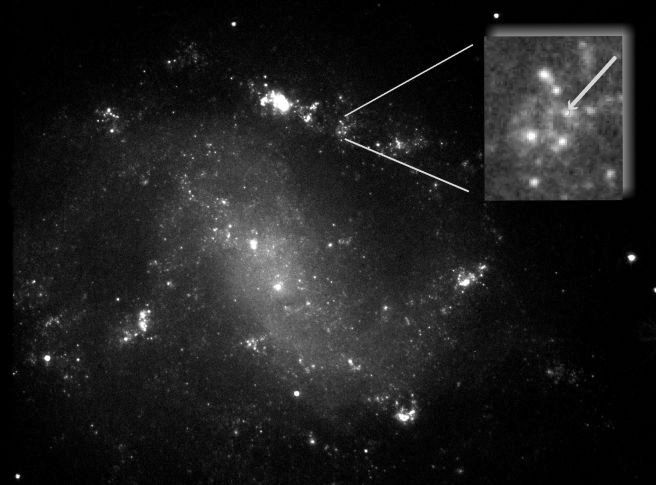Credit & Copyright: S. Holland, J. Hjorth, J. Fynbo
(Survey
of Host Galaxies of GRBs Team),
ESA,
NASA
Explanation:
Modern astronomers keep a long list of things that go bump
in the night.
Near the top are supernovae - the death
explosions of massive stars, and
gamma-ray bursts - the most powerful
explosions seen
across the Universe.
Intriguingly, the
galaxy seen above
in a Hubble Space Telescope
image may have been host to both a supernova and a gamma-ray burst
which were one and the same event.
ESO 184-G82 is a spiral galaxy with a prominent
central bar
and loose spiral arms dotted with bright star-forming regions.
The inset shows an expanded view
of one of the star-forming regions, about 300 light-years across.
Indicated is the location of an
extraordinarily powerful supernova explosion
whose light first reached planet Earth on April 25, 1998.
That location and date also correspond to the detection of an
unusual
gamma-ray burst,
which may be representative of a peculiar
class of
these cosmic high-energy flashes.
So far, this combination is unique and makes barred spiral
ESO 184-G82,
at a distance of only 100 million light-years,
the closest known gamma-ray burst host galaxy.
1999 2000 2001 2002 2003 2004 2005 2006 2007 2008 2009 2010 2011 2012 2013 2014 2015 2016 2017 2018 2019 2020 2021 2022 2023 2024 2025 |
Январь Февраль Март Апрель Май Июнь Июль Август Сентябрь Октябрь Ноябрь Декабрь |
NASA Web Site Statements, Warnings, and Disclaimers
NASA Official: Jay Norris. Specific rights apply.
A service of: LHEA at NASA / GSFC
& Michigan Tech. U.
|
Публикации с ключевыми словами:
gamma-ray burst - supernova - barred spiral galaxy - eso184-g82 - GRB 980425 - SN 1998bw - Сверхновые - гамма-всплески - спиральная галактика с перемычкой
Публикации со словами: gamma-ray burst - supernova - barred spiral galaxy - eso184-g82 - GRB 980425 - SN 1998bw - Сверхновые - гамма-всплески - спиральная галактика с перемычкой | |
См. также:
Все публикации на ту же тему >> | |
